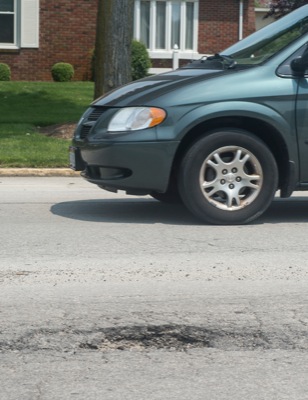Tuesday, July 7th, 2015
City plans to place income tax issue on ballot
By William Kincaid

Photo by Mark Pummell/The Daily Standard
A driver on Monday afternoon steers a minivan past a deep pothole on West Market Street in Celina. Officials want voters to approve a plan allowing the city to use some revenue from a 0.5 percent income tax to repair streets.
CELINA - After weeks of discussion, city council members on Monday night decided to ask voters to allow them to use funds from a current 0.5 percent additional income tax for much-needed street repairs.
"No one likes taxes but I hear a whole lot more complaining about potholes and street conditions than I do about taxes in this community," council president Jason King said at the committee of the whole meeting. "I know everybody wants streets fixed but we have to fund it. We have to do something here and we all know that."
Legislation declaring the city's intent to amend the purpose and duration of the 0.5 percent income tax, now designated solely for police and fire expenses, will be introduced at the next regular council meeting at 7 p.m. Monday. Council members will give the legislation three readings before sending it to the Mercer County Board of Elections for certification for the November ballot.
City officials in November attempted to expand the use of the levy money for street repairs but the ballot measure failed. That language did not include the words "police and fire departments," causing some residents to fear the city would have unrestricted use of the funds.
Police chief Tom Wale and fire chief Doug Wolters support the measure and administrators are confident about the new ballot language.
"It's not just set aside for fire and police emergency. We take care of them but it is for the basic core transportation infrastructure of the city," mayor Jeff Hazel said about the proposed ballot measure.
The levy, originally passed in November 2010, expires at the end of 2017. If the proposed measure is approved, it would extend the tax's duration by five years.
The proposed ballot language states funds from the 0.5 percent income tax would be used for "operational expenses in support of the city's safety departments of fire and police, for capital equipment purchases and capital improvements ... as well as for public right-of-way improvements within the city including streets, curbs and sidewalks."
It would not specify certain percentages to the police and fire departments and street programs.
City law director George Moore conferred with the secretary of state's office in developing the language.
"I spoke with (state counsel) about some of the potential issues they foresaw the last go-around here and we think that by working together here we have come up with appropriate language here that should not be rejected by the secretary of state," Moore said.
Councilman Jeff Larmore said the language appears to be rather straightforward.
City officials agree they need to create a long-term plan to address the city's crumbling, pothole-stricken streets. Street condition is the No. 1 complaint fielded by city officials, who haven't had a consistently funded residential street program in years.
Hazel pointed out that a bulk of the city's general fund carryover, expected to reach as much as $3.8 million next year, comes from the additional 0.5 percent income tax and is earmarked exclusively for police and fire expenses. The 0.5 percent income tax brings in as much as $1.8 million each year.
If the proposal is placed on the ballot and approved by voters, city officials would be able to earmark for street repairs only newly generated revenue - not the existing carryover funds.
"We can't use any portion of that money until we start collecting it after June 1, 2016," Hazel said.
After considering various options, including waiting for the current levy to expire before pursuing another one, officials agreed on amending and extending the current tax.
"We have 75 miles of roads, 15 miles of alleys and 20.9 miles that are desperately in need of repair for a total of $15.8 million," council president Jason King said. "That's yesterday's news and it's still in that condition. We've got to say that. We've got to say, 'We've got $16 million of desperately needed fixes out there for our roads,' and we're only going to generate, at most, $1.8 million a year."
Officials recently talked about other funding sources but learned only a county can pursue a sales tax. They also dismissed the idea of a property tax.
An income tax, though, is controversial because not everyone would pay. Retirees, those on government assistance and tourists use the streets but would not pay for the upkeep.
"This method to fund streets has been explored in an exhaustive manner and in my opinion - the research that I have done and also the communication with the administration and fellow council members - there is no perfectly fair way to fund the street program," councilman Fred LeJuene said. "But I believe in my heart this is the best way to move forward and, across the board, the most reasonable method to fund our street program that we're trying to implement here."
Local businessman/developer John Irmscher was the only member of the public to attend the meeting. He said city officials must effectively inform voters about the need for the taxes not only for the streets but also to attract new business and economic development.
That need, he said, must be presented in simple terms.
"Most residents would understand streets, especially if they're in a situation where theirs is in bad shape," he said. "What you do technically is one issue and your next goal is to communicate to the city."


